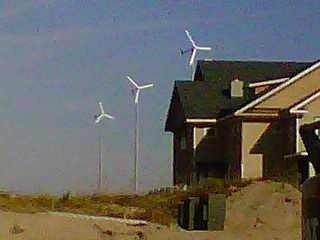Alternative energy requires raw materials. Some of them are quite exotic. Wind turbines and solar cells both use material made from rare-earth oxides. As the name implies, these materials are quite rare. The following article explores the West's vulnerabilities as it turns to technology to solve future energy needs...

A Speculative Rare Earth Power Play
9/24/2010 5:23 AM ET
Copyright © 2010 RTTNews.com, Inc.
http://www.rttnews.com/Content/TopStories.aspx?Id=1427742&SM=1Rare earth elements, also known as green elements, are a group of seventeen metals, whose unique properties have made them indispensable for clean energy technologies, advanced water filtration systems and national defense.
The emerging green energy technologies like hybrid and electric vehicles and wind power turbines; high-tech applications like fiber optics, lasers and hard disk drives and numerous defense systems are dependent on rare earth materials for functionality.
China, which has vast reserves of rare earth metals and controls over 97% of the world's current rare earth supply, has a virtual global monopoly of the metals. As global requirements for rare earth metals continue to spike, China's own domestic use of rare earth elements is also soaring, with internal consumption estimated to be about 60% of production.
With news about China considering banning of exports of rare earth metals making headlines on and off, efforts are being taken up to revive the industry outside China.
The largest non-China rare earth resource in the world is located at Mountain Pass in California, owned by Molycorp Inc. (MCP).
Molycorp is a rare earth producer and technology company. Barely two months of going public, this company's stock has nearly doubled in value, and on Thursday it touched a new intraday high, stoked by reports about China's ban on rare earth exports to Japan.
The Mountain Pass mine owned by Molycorp can produce high quality rare earth oxides, including cerium, lanthanum, neodymium, praseodymium and europium. Operations at the Mountain Pass facility began in 1952 and were suspended in 2002 due to softening prices for rare earth elements and environmental concerns. Though the mine has been inactive, the company is currently producing finished rare earth products from feedstocks that were stockpiled at the site from previous mining campaigns.
In order to raise money to revitalize its mine, the company went public as recently as July 29, pricing its shares at $14 each and raised $379.2 million in the IPO proceeds.
Molycorp is in the process of modernizing its processing facilities and restarting active mining of fresh ore. The company expects mining operations to recommence in 2011 and be in full production in the second half of 2012, when it will begin producing at the rate of forty million pounds of finished Rare Earth products per year.
Under its current business plan, the company intends to spend about $511 million through 2012 to restart mining operations, construct and refurbish processing facilities and other infrastructure at the Mountain Pass facility and expand into metals and alloys production. According to Molycorp, total capital spending is expected to be approximately $53 million this year.
Since its inception, Molycorp has incurred significant operating losses and has yet to make a cent. As of June 30, 2010, the company had an accumulated deficit of $73.7 million. Net sales for the first-half of 2010 were $4.8 million, up from $2.9 million in the comparable year-ago period.
As mentioned, the company's current operations are limited to the production and sale of rare earth oxides from stockpiled concentrates. Lanthanum accounted for 72% and lanthanum oxide accounted for 24% the company's net sales for the six months ended June 30, 2010. Molycorp currently sells 100% of its lanthanum to customers in the United States.
Now, things are looking up as company is optimistic of further expanding its products and markets in the coming months. Molycorp expects increased revenues in the second half of 2010, to be helped by higher rare earth elements prices and sales of additional products to be produced during its second pilot processing campaign.
As China-based producers and suppliers continue to limit the quantity of rare earth oxides available outside of China, its price can be expected to increase. No wonder, the news about China's ban on rare earths exports to Japan, alleged by industry insiders, has brought renewed attention on Molycorp Minerals.
MCP rose nearly 11% to touch a new intraday high of $26.13 on Thursday and closed the day's trading off its highs at $25.73 on an above-average volume of 2.66 million shares.







